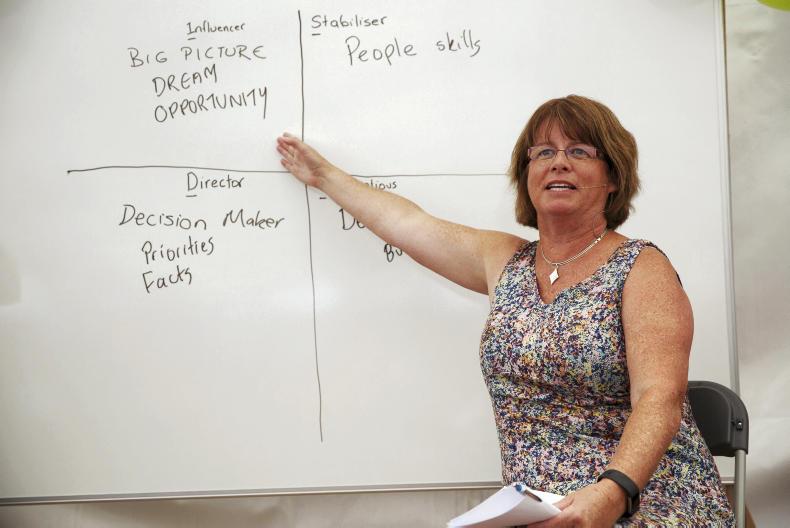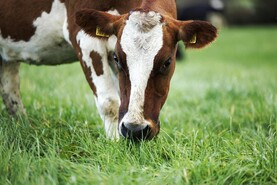Well-known New Zealand dairy consultant Lynaire Ryan is going to offer short courses on business skills to Irish dairy farmers. Lynaire, who has been most recently working as a consultant for Dairy NZ in New Zealand, where her Mark and Measure course has had over 2,500 participants, will be working in Ireland for the next few years.
The Irish course will be called Business Brush Up and will be on for four days over two months in September and October. While the final details have yet to be announced, Lynaire says that the course will cover four areas. “Day one will be about evaluating your existing business – looking at your set of accounts and comparing key performance indicators. Day two will be all about taking steps to improve performance. Day three will be on assessing expansion opportunities while day four will look at personality traits and how to work better as part of a farm team,” Lynaire says.
The content will be delivered by Lynaire, along with Teagasc researchers, advisers and farmers.
Pasture Summit
Details are also emerging of a new event organised jointly by Irish and New Zealand dairy farmers. The first Pasture Summit is taking place in New Zealand this November and will be held in Ireland in 2020.
The two-day event involves one day of conference-style presentations followed by one day of on-farm workshops. The speakers will be top grass-based dairy farmers, researchers, scientists and leading executives from the dairy industry.
Four researchers from Teagasc Moorepark are speaking at the New Zealand event. To coincide with the Pasture Summit event in New Zealand, Lynaire Ryan is leading a Positive Farmers study tour of New Zealand farms for Irish dairy farmers.
After a tough spring, Lynaire has the following advice for Irish farmers.
Have your own plan. Many farmers have expanded but this does not mean that you need to expand. Farmers should work out what they want for themselves and have a clear idea why. The important thing is to be successful within your own skillset.Having the right stocking rate and calving date is essential. To do this, you need to know your grass growth rates and avoid being overstocked. Farmers should calve their cows to grass. Avoid calving too early and having too many mouths to feed.Hit your grass targets. It is not just total growth that is important, but growth at the shoulders. This will help to achieve your average farm cover targets in spring and autumn. Having good soil fertility and grass species come into play here.Good facilities are important. Roadways and multiple access points are the most important, but adequate facilities for housing cows and youngstock are important also. The calving and calf rearing facilities must be streamlined and be labour-efficient.You must adjust the plan. Even the best plans need to be adjusted based on weather and conditions. Basically, when growth is slow the rotation needs to be slow and vice versa. Use supplements strategically based on grass growth.Finally, farmers should get ready ahead of time. Preparing for busy periods will reduce the workload during the busy period. There is no reason why calf sheds cannot be got ready for next spring now. When hiring new staff, don’t wait until calving starts for them to start. New staff should start working during a quiet time to familiarise themselves with the farm and the system.
Well-known New Zealand dairy consultant Lynaire Ryan is going to offer short courses on business skills to Irish dairy farmers. Lynaire, who has been most recently working as a consultant for Dairy NZ in New Zealand, where her Mark and Measure course has had over 2,500 participants, will be working in Ireland for the next few years.
The Irish course will be called Business Brush Up and will be on for four days over two months in September and October. While the final details have yet to be announced, Lynaire says that the course will cover four areas. “Day one will be about evaluating your existing business – looking at your set of accounts and comparing key performance indicators. Day two will be all about taking steps to improve performance. Day three will be on assessing expansion opportunities while day four will look at personality traits and how to work better as part of a farm team,” Lynaire says.
The content will be delivered by Lynaire, along with Teagasc researchers, advisers and farmers.
Pasture Summit
Details are also emerging of a new event organised jointly by Irish and New Zealand dairy farmers. The first Pasture Summit is taking place in New Zealand this November and will be held in Ireland in 2020.
The two-day event involves one day of conference-style presentations followed by one day of on-farm workshops. The speakers will be top grass-based dairy farmers, researchers, scientists and leading executives from the dairy industry.
Four researchers from Teagasc Moorepark are speaking at the New Zealand event. To coincide with the Pasture Summit event in New Zealand, Lynaire Ryan is leading a Positive Farmers study tour of New Zealand farms for Irish dairy farmers.
After a tough spring, Lynaire has the following advice for Irish farmers.
Have your own plan. Many farmers have expanded but this does not mean that you need to expand. Farmers should work out what they want for themselves and have a clear idea why. The important thing is to be successful within your own skillset.Having the right stocking rate and calving date is essential. To do this, you need to know your grass growth rates and avoid being overstocked. Farmers should calve their cows to grass. Avoid calving too early and having too many mouths to feed.Hit your grass targets. It is not just total growth that is important, but growth at the shoulders. This will help to achieve your average farm cover targets in spring and autumn. Having good soil fertility and grass species come into play here.Good facilities are important. Roadways and multiple access points are the most important, but adequate facilities for housing cows and youngstock are important also. The calving and calf rearing facilities must be streamlined and be labour-efficient.You must adjust the plan. Even the best plans need to be adjusted based on weather and conditions. Basically, when growth is slow the rotation needs to be slow and vice versa. Use supplements strategically based on grass growth.Finally, farmers should get ready ahead of time. Preparing for busy periods will reduce the workload during the busy period. There is no reason why calf sheds cannot be got ready for next spring now. When hiring new staff, don’t wait until calving starts for them to start. New staff should start working during a quiet time to familiarise themselves with the farm and the system. 





 This is a subscriber-only article
This is a subscriber-only article









SHARING OPTIONS: